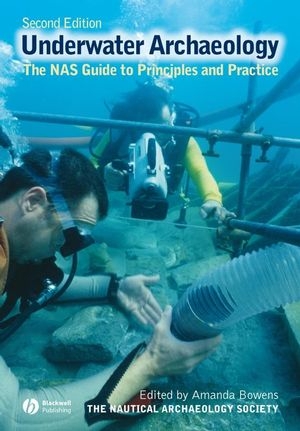
Underwater Archaeology
Wiley-Blackwell (Verlag)
978-1-4051-7591-3 (ISBN)
Underwater Archaeology: The NAS Guide to Principles and Practice provides a comprehensive summary of the archaeological process as applied in an underwater context.
Long awaited second edition of what is popularly referred to as the NAS Handbook
Provides a practical guide to underwater archaeology: how to get involved, basic principles, essential techniques, project planning and execution, publishing and presenting
Fully illustrated with over 100 drawings and new colour graphics
New chapters on geophysics, historical research, photography and video, monitoring and maintenance and conservation
The Nautical Archaeology Society is a non-government organisation formed to further interest in our underwater cultural heritage. The NAS is dedicated to advancing education in nautical archaeology at all levels; to improving techniques in excavating, conservation and reporting; and to encouraging the participation of members of the public at all stages. The Society has published The International Journal of Nautical Archaeology since 1972 and also produces the newsletter Nautical Archaeology, which is free to members.
List of figures. List of plates.
Foreword.
Acknowledgements.
1. The NAS Handbook – why it was written.
2. Underwater archaeology.
What is archaeology?.
What is archaeology under water?.
What is not archaeology under water?.
Closely related and complementary approaches (ethnography and experimental archaeology).
Further information.
3. Getting involved in underwater and foreshore archaeology.
Further information.
4. Basic principles – making the most of the clues.
The importance of underwater sites.
Site types.
The range of evidence on an archaeological site.
Links between categories of evidence.
Using the evidence.
Dating.
Environment and site-formation processes.
The deterioration of wood.
Culture and site-formation processes.
Further information.
5. Project planning.
The project design.
Further information.
6. Safety on archaeological sites under water and on the foreshore.
Risk assessments.
Diving project plan.
Codes of practice.
Control of diving operations.
Working under water.
Potential diving problems and solutions.
Safety during excavation.
Inter-tidal site safety.
Further information.
7. International and national laws relating to archaeology under water.
Jurisdiction – where do the laws apply?.
The regime in international waters.
International salvage law.
Underwater cultural heritage and salvage law.
Ownership of underwater cultural heritage.
Abandonment of ownership.
National legislation.
International conventions.
Case studies.
Further information.
8. Archaeological recording.
The need for recording.
Recording systems.
Planning the recording: what to record.
Recording information on site.
Recording timbers.
Recording contexts.
Recording stratigraphy.
Recording environmental evidence.
Recording samples.
Recording survey results.
Recording plans and sections.
Recording photographic results.
Conservation records.
Identifying archaeological material.
Tags and labelling.
Storing the information.
Computing options and issues.
Geographical information systems.
Explaining, documenting and supervising the system.
Further information.
9. Historical research.
Types of evidence.
Locating primary sources.
The internet.
Methods of research.
Further information.
10. Photography.
Photographic theory.
Digital photography.
Surface photography.
Photographing finds.
Underwater photography.
Underwater photographic techniques.
Digital darkroom.
Mosaics – photo or video.
Video cameras.
Video technique.
Video editing.
Further information.
11. Position-fixing.
Geographical coordinates.
Accuracy.
Methods of position-fixing.
Equipment.
Further information.
12. Underwater search methods.
Positioning.
Coverage.
Safety.
Diver search methods.
13. Geophysical and remote-sensing surveys.
Search patterns, navigation and positioning.
Acoustic systems.
Bathymetric survey.
Echo-sounders.
Multibeam swath systems.
Bottom-classification systems.
Sidescan sonar.
Sub-bottom profiling.
Magnetometry.
Integrated surveys.
Submersibles: ROVs and AUVs.
Aerial photography.
Further information.
14. Underwater survey.
Types of survey.
An initial sketch.
Planning.
Setting up a baseline/control points.
Installing survey points.
The principles of survey.
Offsets.
Ties/trilateration.
Survey using tape-measures, grids and drafting film.
Vertical control (height/depth).
Drawing/planning frames.
Grid-frames.
Processing measurements and drawing up the site-plan.
Three-dimensional computer-based survey.
Acoustic positioning systems.
Positioning the site in the real world.
Further information.
15. Destructive investigative techniques.
Probing.
Sampling.
Excavation.
Further information.
16. Archaeological conservation and first-aid for finds.
Underwater burial environments.
Materials degradation and post-excavation deterioration.
Principal risks to finds during and after recovery.
Principles and procedures for first-aid for underwater finds.
Lifting, handling and transportation.
Approaches to packing and storage.
Sampling and analysis.
Initial cleaning.
Holding and pre-conservation treatment solutions.
Record-keeping.
X-radiography and facilities.
Health and safety.
Insurance.
Checklists.
Further information.
17. Site monitoring and protection.
Monitoring.
Protection.
Further information.
18. Archaeological illustration.
Basic drawing equipment.
Drawing archaeological material.
Recording ‘by eye’.
Recording decoration and surface detail.
Recording constructional and other detail.
Post-fieldwork photography and laser scanning.
Presenting a range of complex information.
Further information.
19. Post-fieldwork analysis and archiving.
Handling material and keeping records.
Post-fieldwork treatment of survey work.
Specialist analysis.
Interpretation and gathering supporting evidence from other sources.
Producing an archaeological archive.
Further information.
20. Presenting, publicizing and publishing archaeological work.
The importance of publicizing (where and when).
Identifying and satisfying an audience.
Methods of presentation.
Writing reports and publications.
A significant achievement and contribution.
Further information.
Appendix 1: anchor recording.
Stone anchors.
Stock anchors.
Further information.
Appendix 2: guns.
The importance of sea-bed recording.
Identification of material.
Classification by methods of loading.
Classification by shape.
Inscriptions and decoration.
Projectiles, charges and tampions.
Recording and illustrating guns.
Further information.
Appendix 3: NAS training programme.
An introduction to foreshore and underwater archaeology.
NAS Part I: certificate in foreshore and underwater archaeology.
NAS Part II: intermediate certificate in foreshore and underwater archaeology.
NAS Part III: advanced certificate in foreshore and underwater archaeology.
NAS Part IV: diploma in foreshore and underwater archaeology.
Further information.
Glossary.
References and further reading.
Index
| Erscheint lt. Verlag | 18.7.2008 |
|---|---|
| Verlagsort | Hoboken |
| Sprache | englisch |
| Maße | 213 x 274 mm |
| Gewicht | 748 g |
| Themenwelt | Geisteswissenschaften ► Archäologie |
| Geisteswissenschaften ► Geschichte ► Allgemeines / Lexika | |
| ISBN-10 | 1-4051-7591-5 / 1405175915 |
| ISBN-13 | 978-1-4051-7591-3 / 9781405175913 |
| Zustand | Neuware |
| Haben Sie eine Frage zum Produkt? |
aus dem Bereich


